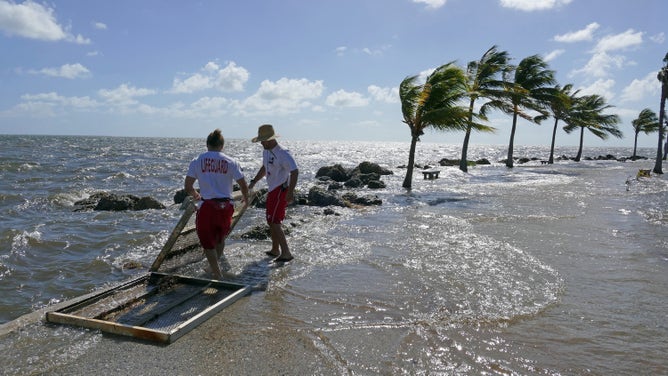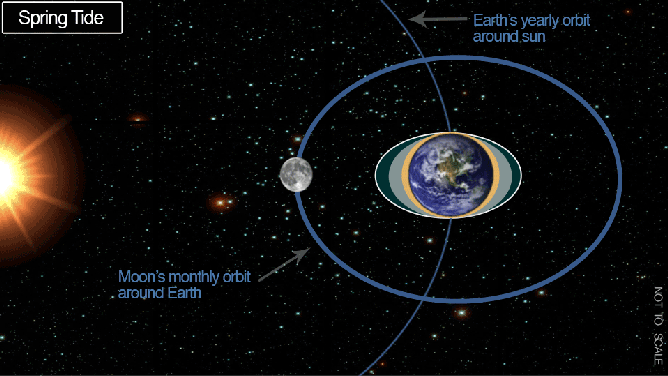What is a king tide or perigean spring tide?
When the sun's and moon's orbits are aligned, the tides get a little extra pull and push

Matheson Hammock Park lifeguards Michael Rosello and Ivan Hernandez lift the grates that filter water from the ocean to the beach along the flooded seawall Monday morning, Oct. 17, 2016 near Miami, Fla.
(Emily Michot/Miami Herald/Tribune News Service / Getty Images)
You're out at the beach, and the tide seems farther out than usual. Later that day, much of the beach is gobbled up by the rising tide - perhaps beyond the typical reach of the daily tides.
If the weather conditions haven't changed much, you're likely at the beach during a "king tide," or as it's more officially known, a "spring tide." But the tides don't have anything to do with royalty or the spring season; instead, it's a factor of the moon and sun's current positions.
To a lesser extent, both the moon and the sun's gravitation pull on the Earth's bodies of water cause the tides. But when the sun's and moon's orbits are aligned, the tides get a little extra pull and push. The extra pull occurs twice every lunar cycle, which lasts 29.5 days. When the moon is full, the moon and sun are directly opposite from Earth's perspective, while during a new moon, the moon and sun are aligned on the same side.

(NOAA)
"In both cases, the gravitational pull of the sun is ‘added’ to the gravitational pull of the moon on Earth, causing the oceans to bulge a bit more than usual," according to NOAA. "This means that high tides are higher and low tides are lower than average." You might imagine the tides "springing forth" with this extra gravitational boost – and there's where the "spring tide" moniker has its origin.
But some spring tides are ‘springier’ than others. The moon's orbit around the Earth is a bit elliptical – meaning there are times when the moon is a little closer to Earth than others. That cycle runs on about 28 days, leaving it a bit offset from the lunar cycle. But about six to eight times a year, the moon will manage to be at new moon or full moon status when it's also at its closest point to Earth. This will give the tides an extra-extra gravitational boost and lead to some of the largest high and low tides of the year. These are known as "perigean spring tides."
How much higher and lower depends on the tidal makeup of the specific body of water, but these perigean spring tides can see swings of an extra foot versus when the moon is at its farthest point from Earth. NOAA noted that Anchorage, Alaska, which typically has a tidal range of over 30 feet, can see three extra feet of water at high tide during perigean spring tides.
Other factors can boost tidal swings even more. Sea levels become higher in late spring and summer due to the sun's position relative to Earth’s equator, plus as the water warms, it expands.
A period of very low atmospheric pressure during storms can also cause higher sea levels and more significant tidal swings. If coastal storms arrive during high tide of spring tides or perigean spring tides, it can exacerbate flooding potential.
Match them all together, and you can get some rather anomalous tides, like this 19-foot tidal swing near Seattle along Puget Sound during a perigean spring tide in May 2021.
You can track the tides for your location at tidesandcurrents.noaa.gov.